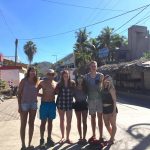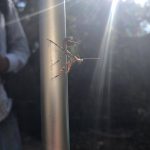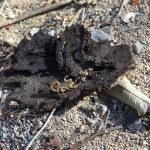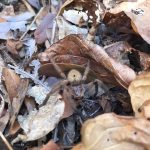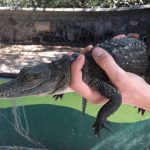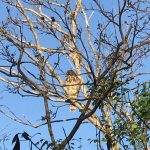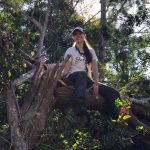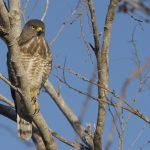ENGLISH
Team TBD
On the first morning of our stay in Chamela, the early risers in the group were rewarded by close-up encounters with mottled owls (Ciccaba virgata) in the courtyard of the station as they came to greet our playbacks! Once the light began to come up and over the horizon and the owls decided to hunker down for the daytime, a San Blas jay (Cyanocorax sanblasianus) started to mob a roadside hawk (Buteo magnirostris) that had set up residence in the area, as an oriole passed through the courtyard.
After all the excitement, the group enjoyed a breakfast of ham and cheese quesadillas with fresh guava juice. Next, we embarked on a morning hike down the Chachalaca trail, taking in the new deciduous scenery. Unfortunately, there has been a dramatic change to the landscapes since the last field course visited Chamela due to a hurricane that passed through the area a year and a half ago. The once open(-ish) trails have been overrun with vines, tree trunks small and large, and new growth vegetation is filling in all of the gaps in the canopy. We saw many cool species on this adventurous hike (really… obstacle course) such as the roadside hawk, groove-billed ani, red-tailed skink, grey hawk, whiptail lizard, turkey vulture, praying mantis, giant crab spider, chacalaca, palo verde beetle, a small rodent, and last but not least a striped-bark scorpion. Near the end of the hike, a rattlesnake was spotted by Amanda but slithered to cover before it could be caught. As Dr. Lougheed described it, the students who were not there to see it must have had “Fomo” (“feeling of missing out”).
After this eventful hike, we met with our research groups to begin working on our field projects in Chamela. The Tequila BioDiversity group (Niki, Danielle, Daniel K and Kalen) are studying the response of prey bird species when they hear a local predator bird call versus a non-native one for which they could have no familiarity. A and Da Boiz (Chris, Daniel G, Tristan and Amanda) are studying habitat preference in the house gecko with respect to background matching and reducing predation risk. The Meruchent Internacional group (Ying, Andrea, Brianna and Anastasia) and both quantifying herbivory leaf damage across patch sizes of a herbaceous plant from their project in Las Joyas, and offering support to other teams. The Aguila Elegante group (Rachel, Donna and Esmar) and Papi’s group (Nicole, Sam, Ulises and Jie Yuen) are studying the abundance and diversity of lizards across an environmental gradient from the shady and protected arroyos to the higher elevation and more exposed hills.
For lunch we had beans, rice and chicken wings with Mexican mole sauce (not made from actual moles…. it’s derived from cacao and spices). Our afternoon was spent debriefing for our projects and tweaking them to enhance their chances of success. We then went on a 6km evening hike down the Tejon trail along which we saw bats, nightjars, and whip scorpions, all the while ducking branches and whole trees that had fallen because of the hurricane. It was very interesting to see the damage of the natural disaster on this once clear trail. Finally, it was time for a hard-earned dinner of Tostada de picadillo, which is ground beef and vegetables on a hard tortilla crust. As the nocturnal animals began their ‘day’, it was time to wrap up our spectacular one.
ESPAÑOL
Equipo TBD
En la primera mañana de nuestra estancia en Chamela, los compañeros tempraneros fueron sorprendidos con el encuentro de un Teolote café (Ciccaba virgata) en los jardines de la estación mientras respondía a grabaciones de la especie. Ya que amaneció y se veía el horizonte, los tecolotes fueron a buscar sus sitios de descanso del día, mientras al mismo tiempo una Urraca de San Blas (Cyanocorax sanblasianus) comenzó a hostigar a la aguililla caminera (Buteo magnirostris) residente en la estación, al momento cruzó tambien una calandria por los jardines.
Después de la emoción, todo el grupo disfrutamos un desayuno de quesadillas con jamón y jugo fresco de guayaba. Después nos aventuramos a una caminata por el sendero chachalaca por el nuevo paisaje de selva caducifolia. Desafortunadamente el hábitat sufrió cambios muy fuertes desde el último curso en Chamela como resultado del Huracán Patricia que pasó a través del área hace un año y medio. El que fué un sendero mas o menos limpio para transitar, está ahora cerrado con ramas y lianas y hasta tróncos grandes y vegetación secundaria que está ganando espacio en el dosel.
De cualquier forma, vimos muchas especies interesantes en esta excursión como el aguililla caminera, anis, lagartijas cola roja, aguililla gris, lagartijas de cola azul, zopilotes, una campamocha, arañas muy grandes, chachalacas, escarabajos, un roedor pequeño dentro de un tronco y también un escorpión. Casi al final de la caminata, Amanda vió una serpiente de cacascabel pero se escurrió por las ramas antes de que la pudieran capturar. Como el Dr. Lougheed lo describió, los estudiantes que no estuvieron presentes en el momento para verla, pues se lo perdieron!
Después de terminada la excursión, nos reunimos con nuestros equipos de trabajo de proyecto en Chamela. El grupo “Biodiversidad y Tequila” (Niki, Danielle, Daniel K y Kalen) propusieron estudiar la respuesta de las aves al llamado de aves de presa. “Amanda y los CHICOS” (Chris, Daniel G, Tristan and Amanda) determinarián las preferencias de sustrato de los Geckos caseros. El equipo internacional MERUCHENT (Ying, Andrea, Brianna y Anastasia) y el equipo “Papi´s (Nicole, Sam, Ulises y Jie Yuen) están ambos analizando datos de sus proyectos en las Joyas y apoyando a los otros equipos en Chamela. El equipo Águila Elegante (Rachel, Donna y Esmar) están estudiando la abundancia de lagartijas en los arroyos.
En la comida nos sirvieron mole con arroz y frijoles. El resto de la tarde la pasamos discutiendo sobre nuestros proyectos y afinando los pormenores para terminarlos con éxito. Después nos fuimos a realizar una caminata vespertina de 6km por el sendero Tejón, la cual fue llena de subidas y bajadas y muchas agachadas por el monton de ramas caídas por el huracán. Aunque fue interesante observar el efecto del huracán sobre el bosque, tambien vimos algunos murcielagos. Finalmente nos fuimos a nuestra bien ganada cena despues de la excursion. Nos dieron tostadas de picadillo con verduras. Mientras la vida animal nocturna comenzaba, para nosotros era hora de irnos a nuestros dormitorios y resumir las aventuras del día.
